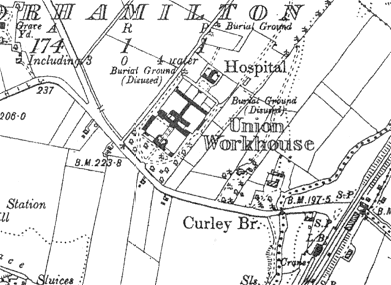Manorhamilton (Manor Hamilton), Co. Leitrim
Manorhamilton (or Manor Hamilton) Poor Law Union was officially declared on 30th August 1839 and covered an area of 246 square miles. Its operation was overseen by an elected Board of Guardians, 18 in number, representing its 10 electoral divisions as listed below (figures in brackets indicate numbers of Guardians if more than one):
Co. Leitrim: Cloonlogher, Drumahaire (2), Drumkeeran (2), Inishmagrath, Killanummery (2), Killarga, Kiltyclogher (2), Lurganboy (2), Manorhamilton (3), Rossinver (2).
The Board also included 6 ex-officio Guardians, making a total of 24. The Board met each week on Thursday.
The population falling within the Union at the 1831 census had been 40,742 with divisions ranging in size from Cloonlogher (population 2,370) to Manorhamilton itself (7,640).
The new workhouse, built in 1840-42, occupied a five-acre site to the east of Manorhamilton and was designed to hold 500 inmates. Its construction cost £5,372 plus £1,015 for fixtures and fittings etc. It was declared fit for the admission of paupers on 1st September 1842 and admitted its first inmates on 8th December that year.
The workhouse site location and layout are shown on the 1910 map below.

Manorhamilton workhouse site, 1910.
The buildings followed Wilkinson's typical layout. An entrance and administrative block at the south-west contained a porter's room and waiting room at the centre with the Guardians' board room on the first floor above.
The main accommodation block had the Master's quarters at the centre, with male and female wings to each side. At the rear, a range of single-storey utility rooms such as bakehouse and washhouse connected through to the infirmary and idiots' wards via a central spine containing the chapel and dining-hall.
During the famine in the mid-1840s, sheds were adapted to accommodate an additional 60 inmates, and an extra storey added to the idiot wards for fever patients. A fever hospital was subsequently erected at the north-east of the site with a burial ground nearby.
At the 1901 census, the population of the Union was 22,334.
Between 1922 and 1936, the workhouse operated as a County Home. The building was demolished in around 1954 to make way for a new County Hospital.
Records
Note: many repositories impose a closure period of up to 100 years for records identifying individuals. Before travelling a long distance, always check that the records you want to consult will be available.
- Leitrim County Library, Main Street, Ballinamore, Co. Leitrim. Holdings: Minute books (1839-1923); Rough minute books (1839-57); Agenda books (1861-76, 1899-1900); Labourers' Act minute books (1886-90); Letter books - incoming letters (1870-92, some gaps); Letter books - outgoing letters (1882-83; 1904-08); Accounts (1852-86, major gaps); Relieving officer's diary (1880-84); Treasurer's rate-in-aid cash book (1849-53); Register of common lodging houses (1889-96).
Bibliography
- Workhouses of the North West Edited by Jack Johnston (1996, WEA)
- The Workhouses of Ireland by John O'Connor (Anvil Books, 1995)
Links
- None.
Unless otherwise indicated, this page () is copyright Peter Higginbotham. Contents may not be reproduced without permission.


